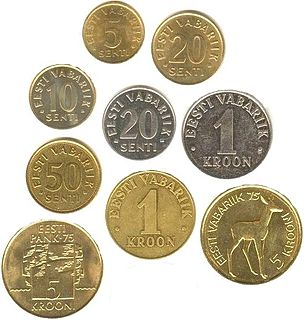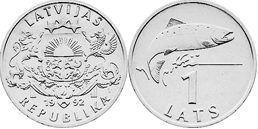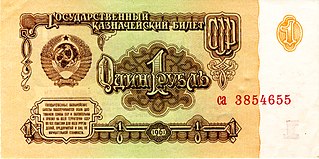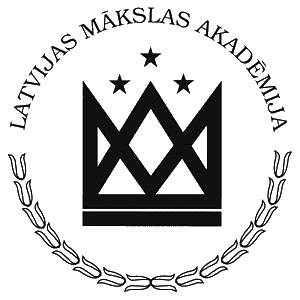
The history of Latvia began around 9000 BC with the end of the last glacial period in northern Europe. Ancient Baltic peoples arrived in the area during the second millennium BC, and four distinct tribal realms in Latvia's territory were identifiable towards the end of the first millennium AD. Latvia's principal river Daugava, was at the head of an important trade route from the Baltic region through Russia into southern Europe and the Middle East that was used by the Vikings and later Nordic and German traders.

The kroon was the official currency of Estonia for two periods in history: 1928–1940 and 1992–2011. Between 1 January and 14 January 2011, the kroon circulated together with the euro, after which the euro became the sole legal tender in Estonia. The kroon was subdivided into 100 cents. The word kroon is related to that of the Nordic currencies and derived from the Latin word corona ("crown"). The kroon succeeded the mark in 1928 and was in use until the Soviet invasion in 1940 and Estonia's subsequent incorporation into the Soviet Union when it was replaced by the Soviet ruble. After Estonia regained its independence, the kroon was reintroduced in 1992 and replaced by the euro in 2011.

The lats was the currency of Latvia from 1922 until 1940 and from 1993 until it was replaced by the euro on 1 January 2014. A two-week transition period during which the lats was in circulation alongside the euro ended on 14 January 2014. It is abbreviated as Ls and was subdivided into 100 santīmi.

The Lithuanian litas (ISO currency code LTL, symbolized as Lt; plural litai or litų was the currency of Lithuania, until 1 January 2015, when it was replaced by the euro. It was divided into 100 centų. The litas was first introduced on 2 October 1922 after World War I, when Lithuania declared independence and was reintroduced on 25 June 1993, following a period of currency exchange from the ruble to the litas with the temporary talonas then in place. The name was modeled after the name of the country. From 1994 to 2002, the litas was pegged to the U.S. dollar at the rate of 4 to 1. The litas was pegged to the euro at the rate of 3.4528 to 1 since 2002. The euro was expected to replace the litas by 1 January 2007, but persistent high inflation and the economic crisis delayed the switch. On 1 January 2015 the litas was switched to the euro at the rate of 3.4528 to 1.

The karbovanets or karbovanet, also known as kupon or coupon, has been a distinct unit of currency in Ukraine during three separate periods of the 20th century. It is also a predecessor currency of today's Ukrainian hryvnia.

The Belarusian ruble or rouble is the official currency of Belarus. The ruble is subdivided into 100 copecks.

The Soviet ruble was the currency of the Union of Soviet Socialist Republics (USSR), introduced in 1922, replacing the Imperial Russian ruble. One ruble was divided into 100 kopeks. Soviet ruble banknotes and coins were produced by the Federal State Unitary Enterprise in Moscow and Leningrad.

The mark was the currency of the Kingdom of Poland and of the Republic of Poland between 1917 and 1924. It was subdivided into 100 fenigs, like its German original after which it was modeled.

The ruble or the British spelling rouble is the currency unit of Russia and some other states in Eastern Europe closely associated with the economy of Russia. As of 2022, the three variants of rubles in circulation are—the Russian ruble in Russia, Abkhazia and South Ossetia, the Belarusian ruble in Belarus and the unrecognised Transnistrian ruble in Transnistria.

Ostmark is the name given to a currency denominated in Mark which was issued by Germany in 1918 for use in a part of the eastern areas under German control at that time, the Ober Ost area. The currency consisted of paper money issued on 4 April 1918 by the Darlehnskasse in Kowno (Kaunas) and was equal to the German Papiermark. The Ostmark circulated alongside the Russian ruble and the Ostruble, with two Ostmark equal to one Ostruble.
The auksinas was the name of two currencies of Lithuania: silver coin minted in 1564 equal to 30 Lithuanian groschens and paper German ostmark banknotes that circulated in Lithuania in the aftermath of World War I.

The Art Academy of Latvia is an institution of higher education and scientific research in art, located in Riga, Latvia. The neo-Gothic brick building is located on Krišjānis Valdemārs Street, next to the National Museum of Art.

Valērijs Kargins or Valery Mikhailovich Kargin is a Latvian economist and banker was the president of Parex Banka, from 1998 to 2008. In October of 2000, he and Viktor Krasovitsky had accumulated over 200 million lats together. He created the first travel agency and the first currency exchange corporation in the Soviet Union.

Postal history in the territory that now constitutes Latvia began during the 13th century, when the Archbishopric of Riga was included to the area of postal operations of the Monastic state of the Teutonic Knights and the Hanseatic League. In 1580 the Hanseatic League issued their first known regulations on courier work and payroll, regulations that also were active in the territory that now constitutes Latvia.

Salaspils camp was established at the end of 1941 at a point 18 km (11 mi) southeast of Riga (Latvia), in Salaspils. The Nazi bureaucracy drew distinctions between different types of camps. Officially, it was the Salaspils Police Prison and Re-Education Through Labor Camp. It was also known as camp Kurtenhof after the German name for the city of Salaspils.

5 lats coin was a Latvian lat coin minted in 1929, 1931 and 1932. It became a popular symbol of independence during the Soviet occupation. It was reproduced in several modern commemorative coins of Latvia and is used on the national sides of the Latvian 1 and 2 euro coins. The reverse design was featured on the Ls 500 banknote and in watermarks of all lats banknotes.
Russia's monetary reform of 1993 took place from 26 July to 7 August 1993.

Parex Bank was a Latvian bank founded in 1992 by Valērijs Kargins and Viktors Krasovickis as a privately owned full-service banking company in Riga, Latvia that was very dominant in currency exchange in the 1990s promoting itself as "We are closer than Switzerland!". It had local and international clients in both the West and Russia with close ties to the Tambovskaya Russian mafia in St Petersburg and Vladimir Putin. As the second largest bank in Latvia in 2008, its failure and state takeover was one of the major events of the 2008–2010 Latvian financial crisis. On 1 August 2010, Parex Banka was split into a new bank Citadele Banka and Reverta, an asset recovery company. Citadele was then sold to a group of United States investors while Reverta sued the founders Kargins and Krasovickis for €88 million due to 14 highly irregular loans and deposits between 1995 and 2008.















